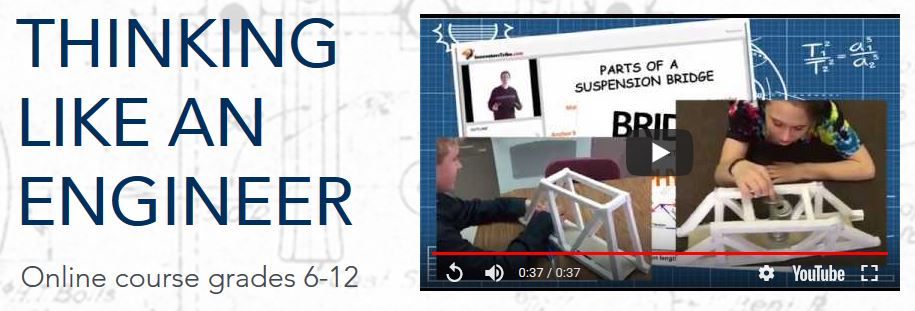
One of the best parts about homeschool science is that it's usually easy to add in cool hands-on projects and experiments. Innovators Tribe has developed entire online courses that seamlessly integrate learning videos, hands-on activities, and design challenges to make a fun learning experiences for middle and high school students. Lauren (and my husband Tim) have been using the Thinking Like an Engineer program recently. It is serving a dual purpose around here --both introducing engineering concepts and providing resources for the Science Olympiad Roller Coaster event.

Thinking Like an Engineer is an introductory course designed to expose students to the math and science skills used by engineers and to show them practical examples of what sorts of problems engineers solve.
The course syllabus outlines learning objectives for this course:
Wow! It looks like that list would make a pretty good exam for a high schooler. Since Lauren is only in sixth grade and hasn't had a lot of previous science experience, my primary goal was for her to have an enjoyable (not stressful) experience exploring engineering concepts. Since she had already signed up for our homeschool Science Olympiad team and asked to be on the Roller Coaster build team, I also hoped that she'd be able to glean some helpful construction tips.
The program turned out to be far more than we ever imagined. Tim and Lauren skipped ahead a bit and started with the third unit -- Engineering Rollercoasters. The online coursework portion included a bit of video instruction, links to video explanations, and a short comprehension/memory quiz at the end.
Lauren learned a bit about the difference between potential and kinetic energy:
She was then introduced to some simple physics equations to calculate each:
Finally, with a bit of help from Dad, she was able to determine all sorts of information, including how high the first hill needed to be in order for the roller coaster to make it around a loop.
She doesn't fully understand the equations, but she did grasp the concept that making the hill higher meant that the roller coaster car would be going faster and could therefore make it around the loop. Her Science Olympiad roller coaster probably won't have any loops, but it will need the marbles to go fast enough to jump from one section of track to another.
Our engineers then moved on to the coolest part of the roller coaster unit -- making a model roller coaster out of paper. Thinking Like an Engineer provided paper templates and complete instructions. We printed out the templates on cardstock and were ready to start building. Lauren and her teammate were easily able to construct the track and start experimenting to see how far they could get their marble to jump. (Since their Science Olympiad event gives bonus points based on horizontal gaps in the track, we are focused right now on getting the marble to make successful jumps instead of doing cool loops and twists.)
What could be cooler than designing your own roller coaster? I'm not sure, but it could be building a tower out of four sheets of paper and one foot of masking tape (unit 1), experimenting with 3D computer design software (units 2 and 5), or designing a bridge (unit 4).
I love when science concepts become real with hands-on activities and not just pages of reading assignments. Innovators Tribe makes engineering fun by teaching students how to Think Like an Engineer with this course. They also offer a Think Like an Architect program that promises to be equally exciting.









No comments:
Post a Comment